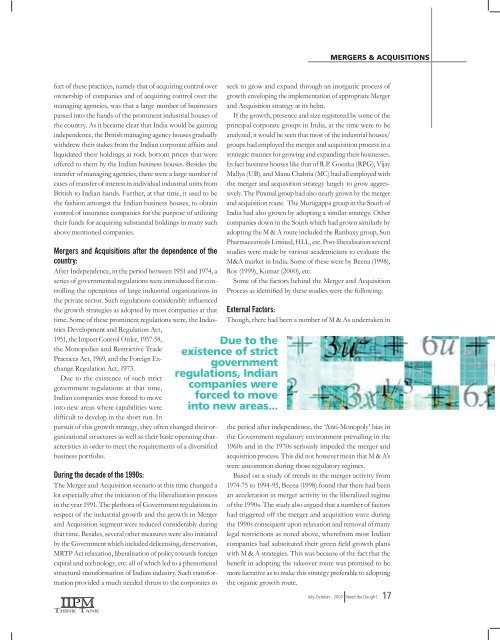india going global.indd - The IIPM Think Tank
india going global.indd - The IIPM Think Tank
india going global.indd - The IIPM Think Tank
You also want an ePaper? Increase the reach of your titles
YUMPU automatically turns print PDFs into web optimized ePapers that Google loves.
MERGERS & ACQUISITIONS<br />
fect of these practices, namely that of acquiring control over<br />
ownership of companies and of acquiring control over the<br />
managing agencies, was that a large number of businesses<br />
passed into the hands of the prominent industrial houses of<br />
the country. As it became clear that India would be gaining<br />
independence, the British managing agency houses gradually<br />
withdrew their stakes from the Indian corporate affairs and<br />
liquidated their holdings at rock bottom prices that were<br />
offered to them by the Indian business houses. Besides the<br />
transfer of managing agencies, there were a large number of<br />
cases of transfer of interest in individual industrial units from<br />
British to Indian hands. Further, at that time, it used to be<br />
the fashion amongst the Indian business houses, to obtain<br />
control of insurance companies for the purpose of utilizing<br />
their funds for acquiring substantial holdings in many such<br />
above mentioned companies.<br />
Mergers and Acquisitions after the dependence of the<br />
country:<br />
After Independence, in the period between 1951 and 1974, a<br />
series of governmental regulations were introduced for controlling<br />
the operations of large industrial organizations in<br />
the private sector. Such regulations considerably influenced<br />
the growth strategies as adopted by most companies at that<br />
time. Some of these prominent regulations were, the Industries<br />
Development and Regulation Act,<br />
1951, the Import Control Order, 1957-58,<br />
the Monopolies and Restrictive Trade<br />
Practices Act, 1969, and the Foreign Exchange<br />
Regulation Act, 1973.<br />
Due to the existence of such strict<br />
government regulations at that time,<br />
Indian companies were forced to move<br />
into new areas where capabilities were<br />
difficult to develop in the short run. In<br />
pursuit of this growth strategy, they often changed their organizational<br />
structures as well as their basic operating characteristics<br />
in order to meet the requirements of a diversified<br />
business portfolio.<br />
During the decade of the 1990s:<br />
<strong>The</strong> Merger and Acquisition scenario at this time changed a<br />
lot especially after the initiation of the liberalization process<br />
in the year 1991. <strong>The</strong> plethora of Government regulations in<br />
respect of the industrial growth and the growth in Merger<br />
and Acquisition segment were reduced considerably during<br />
that time. Besides, several other measures were also initiated<br />
by the Government which included delicensing, derservation,<br />
MRTP Act relaxation, liberalisation of policy towards foreign<br />
capital and technology, etc. all of which led to a phenomenal<br />
structural transformation of Indian industry. Such transformation<br />
provided a much needed thrust to the corporates to<br />
seek to grow and expand through an inorganic process of<br />
growth enveloping the implementation of appropriate Merger<br />
and Acquisition strategy at its helm.<br />
If the growth, presence and size registered by some of the<br />
principal corporate groups in India, at the time were to be<br />
analyzed, it would be seen that most of the industrial houses/<br />
groups had employed the merger and acquisition process in a<br />
strategic manner for growing and expanding their businesses.<br />
In fact business houses like that of R.P. Goenka (RPG), Vijay<br />
Mallya (UB), and Manu Chabria (MC) had all employed with<br />
the merger and acquisition strategy largely to grow aggressively.<br />
<strong>The</strong> Piramal group had also nearly grown by the merger<br />
and acquisition route. <strong>The</strong> Murugappa group in the South of<br />
India had also grown by adopting a similar strategy. Other<br />
companies down in the South which had grown similarly by<br />
adopting the M & A route included the Ranbaxy group, Sun<br />
Pharmaceuticals Limited, HLL, etc. Post-liberalisation several<br />
studies were made by various academicians to evaluate the<br />
M&A market in India. Some of these were by Beena (1998),<br />
Roy (1999), Kumar (2000), etc.<br />
Some of the factors behind the Merger and Acquisition<br />
Process as identified by these studies were the following:<br />
External Factors:<br />
Though, there had been a number of M & As undertaken in<br />
Due to the<br />
existence of strict<br />
government<br />
regulations, Indian<br />
companies were<br />
forced to move<br />
into new areas...<br />
the period after independence, the ‘Anti-Monopoly’ bias in<br />
the Government regulatory environment prevailing in the<br />
1960s and in the 1970s seriously impeded the merger and<br />
acquisition process. This did not however mean that M & A’s<br />
were uncommon during those regulatory regimes.<br />
Based on a study of trends in the merger activity from<br />
1974-75 to 1994-95, Beena (1998) found that there had been<br />
an acceleration in merger activity in the liberalized regime<br />
of the 1990s. <strong>The</strong> study also argued that a number of factors<br />
had triggered off the merger and acquisition wave during<br />
the 1990s consequent upon relaxation and removal of many<br />
legal restrictions as noted above, wherefrom most Indian<br />
companies had substituted their green field growth plans<br />
with M & A strategies. This was because of the fact that the<br />
benefit in adopting the takeover route was premised to be<br />
more lucrative as to make this strategy preferable to adopting<br />
the organic growth route.<br />
July-October - 2007 Need the Dough<br />
17





![[Feb 2008, Volume V Annual Issue] Pdf File size - The IIPM Think Tank](https://img.yumpu.com/43961117/1/190x245/feb-2008-volume-v-annual-issue-pdf-file-size-the-iipm-think-tank.jpg?quality=85)
![[June 2008, Volume V Quarterly Issue] Pdf File size - The IIPM Think ...](https://img.yumpu.com/41693247/1/190x245/june-2008-volume-v-quarterly-issue-pdf-file-size-the-iipm-think-.jpg?quality=85)







![[Dec 2007, Volume 4 Quarterly Issue] Pdf File size - The IIPM Think ...](https://img.yumpu.com/29766298/1/190x245/dec-2007-volume-4-quarterly-issue-pdf-file-size-the-iipm-think-.jpg?quality=85)

![[Volume VI | Quarterly Issue: 31st May 2009] Pdf File size](https://img.yumpu.com/27796051/1/190x245/volume-vi-quarterly-issue-31st-may-2009-pdf-file-size.jpg?quality=85)